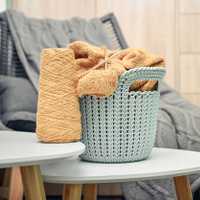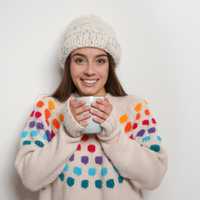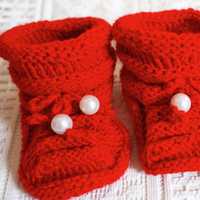Choosing the Very Best Yarn for a Knitting Project Made Easy
By Katherine Foster
Choosing the Very Best Yarn for a Knitting Project Made Easy
By Katherine Foster
Planning to knit a scarf? There is much more that goes into the process than simply picking scarf yarns off the shelf at the local craft store. Buying a pattern can certainly help, as it will often suggest which yarns are best. Another option is to check with a store employee or other knowledgeable individual to see what they think would work.
The bottom line is that the knitter wants to be sure their scarf turns out exactly as planned, and not every type of scarf yarns works with every pattern. Here are some things to know about yarns before making a decision, provided there is no expert to help out.
The gauge of yarn
Most patterns specify a gauge of yarn for the project. This is mostly to ensure that the scarf knitted matches the same size as the one in the photo. Otherwise, one may produce something completely different.
The information on gauge will be listed at the start of a pattern, usually above or before the instructions begin. It is also referred to as tension. Gauge is basically the number of rows and stitches that occur over four square inches or 10 square centimetres. It will also relay what stitch pattern and needle is to be used.
It's important to also take into consideration other characteristics of the scarf yarns to include:
• Texture
• Fibre
• Drape
• Colour
There is a good chance the feel and look of the scarf knitted will not completely match the picture chosen depending upon the type of scarf yarns one is working with. Be wary of novelty yarns including those with glitter and jewels; they can look totally different when knitted up. It's more than okay to go ahead and use these scarf yarns, but many go with traditional types for better results.
At times, there will be knitted samples to browse through which is a great help! If the store chosen offers this feel lucky. It's a blessing to get this type of preview.
Colour and Texture for Scarf Yarns
A basic rule to remember when choosing scarf yarns is this:
Single Piles = Rustic, and relaxed.
Piled and Twisted = Soft, and sophisticated.
Anyone interested in working cables and stitch patterns into their scarf will find success when following this tip.
Piles is the name for scarf yarns that are made up of one or more strands. Thickness is wholly dependent upon the number of piles. Though they may be thin, it's possible for a single-ply to be heavier than a 4 ply depending on the yarn itself.
Novelty Yarns
Some novelty yarns present difficult situations for even the most experienced knitters. For those who are inexperienced, they should choose scarf yarns that are dyed or painted. That way they can enjoy a variation in colour, but still be able to clearly see what they are doing. Fixing mistakes is nearly impossible when the texture is crazy. Along those lines, the wilder the yarn the easier the pattern should be.
Securing Help
Shop in a specialty yarn store to get the best advice on scarf yarns, and knitting as well. If one needs help, those individuals will be there to help! Ask as many questions as necessary about the scarf yarn needed. You'll want to know if it is colourfast, if it pills or stretches, if it's easy to use and if it works with the pattern chosen. One should also inquire as to the size needle necessary if they don't already know. No matter what scarf yarns are chosen, know that more expensive doesn't necessarily mean better quality, it's far more important that the creator and recipient love the yarn.
Little Houndales Knits has been offering the finest in yarns, wool, patterns, needles, bags and accessories for knitting enthusiasts since 2010. They began by securing space at local farmer's markets and have now grown to an online store as well. The desire to provide proper wool to knitters helped give them the drive to build up a large selection of yarns made from their own sheep, and other products from only premium and favorite brands as well as niche brands. In addition to the online shop, buyers can visit Little Houndales Farm if desired, and get advice or browse products. Their website can be found at http://www.littlehoundalesknits.com.
Article Source: http://EzineArticles.com/expert/Katherine_Foster/1967639
Planning to knit a scarf? There is much more that goes into the process than simply picking scarf yarns off the shelf at the local craft store. Buying a pattern can certainly help, as it will often suggest which yarns are best. Another option is to check with a store employee or other knowledgeable individual to see what they think would work.
The bottom line is that the knitter wants to be sure their scarf turns out exactly as planned, and not every type of scarf yarns works with every pattern. Here are some things to know about yarns before making a decision, provided there is no expert to help out.
The gauge of yarn
Most patterns specify a gauge of yarn for the project. This is mostly to ensure that the scarf knitted matches the same size as the one in the photo. Otherwise, one may produce something completely different.
The information on gauge will be listed at the start of a pattern, usually above or before the instructions begin. It is also referred to as tension. Gauge is basically the number of rows and stitches that occur over four square inches or 10 square centimetres. It will also relay what stitch pattern and needle is to be used.
It's important to also take into consideration other characteristics of the scarf yarns to include:
• Texture
• Fibre
• Drape
• Colour
There is a good chance the feel and look of the scarf knitted will not completely match the picture chosen depending upon the type of scarf yarns one is working with. Be wary of novelty yarns including those with glitter and jewels; they can look totally different when knitted up. It's more than okay to go ahead and use these scarf yarns, but many go with traditional types for better results.
At times, there will be knitted samples to browse through which is a great help! If the store chosen offers this feel lucky. It's a blessing to get this type of preview.
Colour and Texture for Scarf Yarns
A basic rule to remember when choosing scarf yarns is this:
Single Piles = Rustic, and relaxed.
Piled and Twisted = Soft, and sophisticated.
Anyone interested in working cables and stitch patterns into their scarf will find success when following this tip.
Piles is the name for scarf yarns that are made up of one or more strands. Thickness is wholly dependent upon the number of piles. Though they may be thin, it's possible for a single-ply to be heavier than a 4 ply depending on the yarn itself.
Novelty Yarns
Some novelty yarns present difficult situations for even the most experienced knitters. For those who are inexperienced, they should choose scarf yarns that are dyed or painted. That way they can enjoy a variation in colour, but still be able to clearly see what they are doing. Fixing mistakes is nearly impossible when the texture is crazy. Along those lines, the wilder the yarn the easier the pattern should be.
Securing Help
Shop in a specialty yarn store to get the best advice on scarf yarns, and knitting as well. If one needs help, those individuals will be there to help! Ask as many questions as necessary about the scarf yarn needed. You'll want to know if it is colourfast, if it pills or stretches, if it's easy to use and if it works with the pattern chosen. One should also inquire as to the size needle necessary if they don't already know. No matter what scarf yarns are chosen, know that more expensive doesn't necessarily mean better quality, it's far more important that the creator and recipient love the yarn.
Little Houndales Knits has been offering the finest in yarns, wool, patterns, needles, bags and accessories for knitting enthusiasts since 2010. They began by securing space at local farmer's markets and have now grown to an online store as well. The desire to provide proper wool to knitters helped give them the drive to build up a large selection of yarns made from their own sheep, and other products from only premium and favorite brands as well as niche brands. In addition to the online shop, buyers can visit Little Houndales Farm if desired, and get advice or browse products. Their website can be found at http://www.littlehoundalesknits.com.
Article Source: http://EzineArticles.com/expert/Katherine_Foster/1967639



